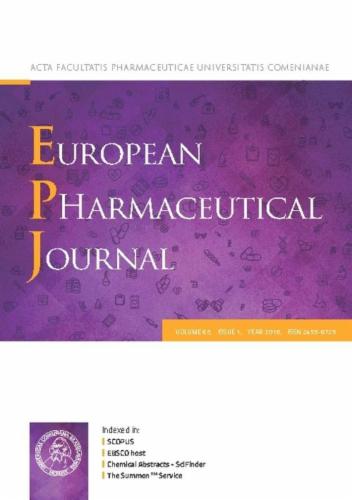靶向细菌和人左旋多巴脱羧酶改善帕金森病药物治疗:新抑制剂的发现和表征
IF 4.3
3区 医学
Q1 PHARMACOLOGY & PHARMACY
引用次数: 0
摘要
帕金森病(PD)是一种常见的神经退行性疾病,通常用左旋多巴治疗,它减轻了疾病的运动症状。然而,左旋多巴在外周组织中的代谢会阻碍其生物利用度并导致不良副作用。因此,氨基酸脱羧酶(AADC)抑制剂的共同施用是必要的,但仍然有高达50%的左旋多巴可能无法到达大脑。最近的证据表明,肠道微生物,特别是粪肠球菌,也能够利用微生物酪氨酸脱羧酶(TyrDC)酶代谢左旋多巴并影响其生物利用度。本研究的主要目的是开发针对肠道微生物和宿主左旋多巴脱羧的抑制剂。首先,结合3种方法,对含有158,000个抗粪肠杆菌TyrDC化合物的文库进行虚拟筛选,分别是:针对粪肠杆菌TyrDC同源性模型的分子对接、基于结构的药效团模型以及基于左旋多巴、卡比多巴(AADC抑制剂)和(S)-α-氟甲基酪氨酸(TyrDC抑制剂)的形状相似性搜索。采用基于细胞的粪肠杆菌法对394个化合物进行了体外左旋多巴代谢抑制试验。三种活性最高的化合物(在100µM下抑制49% -92%)共享相似的支架和一组市售和内部合成的类似物,然后对纯化的TyrDC和AADC酶进行评估。对TyrDC和AADC抑制作用最强的化合物IC50值分别为23µM / 144µM(化合物1)、42µM / 199µM(化合物2)和51µM / 182µM(化合物3)。在相同浓度范围内,这些化合物对HeLa细胞也有细胞毒作用,对粪肠杆菌也有一定的抗菌活性。本文提出的化合物的核心结构可以作为开发针对TyrDC和AADC的新抑制剂的起点,并为个性化PD治疗提供了有希望的途径,特别是对于表达左旋多巴代谢TyrDC酶的高水平肠道微生物的患者。本文章由计算机程序翻译,如有差异,请以英文原文为准。
Targeting bacterial and human levodopa decarboxylases for improved drug treatment of Parkinson's disease: Discovery and characterization of new inhibitors
Parkinson's disease (PD) is a common neurodegenerative disease, typically treated with levodopa, which alleviates the motor symptoms of the disease. However, levodopa metabolism in peripheral tissues hampers its bioavailability and leads to undesired side-effects. Therefore, co-administration of amino acid decarboxylase (AADC) inhibitors is necessary, but still, up to 50 % of levodopa may not reach the brain. Recent evidence suggests that gut microbes, especially Enterococcus faecalis, are also able to metabolize levodopa and affect the bioavailability by utilizing microbial tyrosine decarboxylase (TyrDC) enzyme. The main aim of this study was to develop inhibitors targeting gut microbial and host decarboxylation of levodopa. First, a virtual screen of a library of 158,000 compounds against E. faecalis TyrDC was conducted, combining three methods: molecular docking against the E. faecalis TyrDC homology model, structure-based pharmacophore model, and shape similarity searches based on levodopa, carbidopa (AADC inhibitor) and (S)-α-fluoromethyltyrosine (TyrDC inhibitor). A total of 394 compounds were selected and tested in vitro by using a cell-based E. faecalis assay measuring inhibition of levodopa metabolism. Three most active compounds (49-92% inhibition at 100 µM) sharing a similar scaffold and a set of commercially available and in-house synthesized analogs were then assessed against purified TyrDC and AADC enzymes. The IC50 values for the most potent compounds for TyrDC and AADC inhibition were 23 µM / 102 µM (compound 1), 42 µM / 154 µM (compound 2) and 51 µM / 182 µM (compound 3), respectively. These compounds also displayed cytotoxic effects on HeLa cells and modest antibacterial activity against E. faecalis at the same concentration range. The core structure of the compounds presented here can serve as a starting point for the development of a new inhibitor class against TyrDC and AADC, and offers a promising avenue for personalized PD treatment, particularly for patients with high levels of gut microbes expressing the levodopa metabolizing TyrDC enzyme.
求助全文
通过发布文献求助,成功后即可免费获取论文全文。
去求助
来源期刊
CiteScore
9.60
自引率
2.20%
发文量
248
审稿时长
50 days
期刊介绍:
The journal publishes research articles, review articles and scientific commentaries on all aspects of the pharmaceutical sciences with emphasis on conceptual novelty and scientific quality. The Editors welcome articles in this multidisciplinary field, with a focus on topics relevant for drug discovery and development.
More specifically, the Journal publishes reports on medicinal chemistry, pharmacology, drug absorption and metabolism, pharmacokinetics and pharmacodynamics, pharmaceutical and biomedical analysis, drug delivery (including gene delivery), drug targeting, pharmaceutical technology, pharmaceutical biotechnology and clinical drug evaluation. The journal will typically not give priority to manuscripts focusing primarily on organic synthesis, natural products, adaptation of analytical approaches, or discussions pertaining to drug policy making.
Scientific commentaries and review articles are generally by invitation only or by consent of the Editors. Proceedings of scientific meetings may be published as special issues or supplements to the Journal.

 求助内容:
求助内容: 应助结果提醒方式:
应助结果提醒方式:


